
Outdoor wood furnaces aren’t for everybody. They have a niche in the central heating market, but they fill that niche well. If the circumstances are right, few heating options provide a more efficient, dependable, and comprehensive heating source. The drawbacks are simple enough. You need to have a reasonably convenient source of wood and you need to have a viable place to put the furnace installation. Obviously, this lends itself to more rural homes, but you don’t need to live in the middle of nowhere or in a heavily wooded area to make this a viable heating option.
Advantages of an Outdoor Wood Furnace
Choosing an outdoor wood burning furnace will give you immediate and long term benefits. You can eliminate most of your utility bill for your home. That’s always nice. Several heating options can save you a lot on your monthly bills, though. An outdoor wood furnace can heat several buildings at once, including a stand alone garage, a shed, or—with a higher-rated furnace and good insulation—multiple homes. Not too many heating systems can say that.
Another good bonus for moving your heating source outside is that it eliminates one more fire hazard from your home. For even better safety, make sure you choose a model that has fail-safes for pressure, loss of electricity, and flash burning. A good outdoor wood furnace should be safer than many other heating sources, but a low-end furnace can expose you to unnecessary risks.
Make an Investment
An outdoor wood burning furnace isn’t an installation you want to skimp on. Performance between models and companies can vary greatly. Different designs are better for efficiency, others are better for producing greater amounts of heat. The outdoor structure of the furnace must provide its own insulation and less-efficient features will show immense heat loss given the furnace is exposed to the elements. Dozens of factors determine overall performance, but the furnace door and a good exhaust system are paramount.
You should also make an investment to ensure your home has a good overall insulation rating, but probably not for the reason you think. An outdoor wood furnace is an efficient way of heating your home, regardless, but good insulation will reduce the time you spend gathering wood and feeding it to the furnace. A well-insulated home with a high-rated outdoor furnace will keep this task from getting tedious. If you really want a premium heating system, radiant flooring will also help your outdoor wood burning furnace go a long way.
Longevity and Maintenance
Again, the quality of your furnace will vary greatly on your model and this includes its longevity. A low-end, poorly maintained furnace may last less than ten years. On the other hand, a high-end, properly maintained furnace can last indefinitely. Periodic inspections and the occasional cleaning will ensure your furnace is operating as it should. Keeping the furnace free from rust and creosote (a wood burning by product) are the most important things for proper maintenance.
 Air Conditioner Condenser Coil Costs, Repairs & Replacements
Air Conditioner Condenser Coil Costs, Repairs & Replacements  Whole House Humidifiers
Whole House Humidifiers  Choosing Green: Boilers and Radiator Heating Systems
Choosing Green: Boilers and Radiator Heating Systems  Consider Wood-Burning Furnaces
Consider Wood-Burning Furnaces  Outdoor Heaters: a Refuge from the Cold
Outdoor Heaters: a Refuge from the Cold 

After weighing the pros and cons of investing in an outdoor wood furnace, you should understand the importance of choosing a high quality unit. The Crown Royal Pristine Series includes features that set it apart from the competition. Here are just some of the features that make this EPA Phase 2 Qualified series simple to operate and extremely efficient:
• Located on the top of the stove is an easy to read water level indicator and a stainless steel flue that can easily be extended using additional lengths.
• Air panels constructed out of 409 stainless steel are hung inside the firebox. The air panels prevent damage of the firebox and structure by distributing the air. They are also easily replaceable.
• The refractory base, or gasification manifold, directs hot air into the combustion zone, igniting the gases and creating a flame in the second combustion chamber.
• The firebox and secondary combustion chamber door are equipped with roller bearing latches and silicone rope gasket, creating a very tight seal.
• The Pristine Series is equipped with stainless steel twisted tape turbulators that serve a dual purpose. Activate the turbulators using the heat exchanger cleaner handle located in the front of the stove to remove any build-up in the heat exchanger tubes. With their snug fit spiral design, the turbulators slow down the air flow, allowing maximized heat transfer.
• A cleanout door is conveniently located in the back of the stove to remove any ash knocked down from the turbulators.
• To prevent smoke exiting out the firebox door during loading, there is a load switch located on the control panel that will turn the blower fan on for 90 seconds.
The Crown Royal Pristine Series uses negative pressure gasification. Gasification is a process that uses high temperatures, dry wood and a controlled amount of air. This combination creates gases inside the firebox, which are forced downward into the secondary combustion chamber where it is then ignited, heating the water in the heat exchanger tubes. This process also greatly decreases smoke production while burning.